WEBSITE HIGHLIGHTS: CARAT WEIGHT AND SIZE CHART
The size of a diamond (millimeter length and width) does not grow in direct proportion to the carat weight. In other words, a one-carat diamond is not twice as big as a half-carat stone. Our web site has a page with the typical millimeter sizes of various carat weight stones for each of the major diamond shapes.
Check out this carat weight and size information
DIAMOND SHOPPER MISTAKES: BEWARE OF THE TRADE-IN TRAP
 Beware of the “trade-in” trap! In recent weeks, we have heard story after story of how diamond shoppers got so focused on trading-in their old diamond that they forgot to look for the best value on the new diamond. Unlike used cars, there is not an easy and well-established market for used diamonds. This is in part due to the De Beers marketing campaign highlighted by the logo; a diamond is forever. One of the strategies of that marketing effort is that women will keep diamonds in the family and not sell diamonds they no longer wear. This benefits De Beers and the diamond industry because the demand for “new” diamonds is only slightly diluted by “used” diamonds being resold.
Beware of the “trade-in” trap! In recent weeks, we have heard story after story of how diamond shoppers got so focused on trading-in their old diamond that they forgot to look for the best value on the new diamond. Unlike used cars, there is not an easy and well-established market for used diamonds. This is in part due to the De Beers marketing campaign highlighted by the logo; a diamond is forever. One of the strategies of that marketing effort is that women will keep diamonds in the family and not sell diamonds they no longer wear. This benefits De Beers and the diamond industry because the demand for “new” diamonds is only slightly diluted by “used” diamonds being resold.
Often the consumer who wants to trade up to a bigger diamond only to be caught up in the trade-in trap. The jeweler gives them a trade in value to apply towards a new diamond. Whereas the knowledgeable car buyer will get the lowest price on the new car and then negotiate for the trade in, too many diamond shoppers do just the opposite. They seek someone who will give them a quick trade in value and they pay top price for their new diamond.
We have had numerous clients recently who discovered that they paid more out of pocket after the trade in, than they could have purchased the new diamond from us. In other words, they would have been better off buying the new diamond from us and keeping the old diamond. For example, one client paid $26,000 for a diamond we could have sold him for $15,000. The jeweler gave him a trade-in value of $9,000 for his old diamond and the client paid $17,000 out-of-pocket. Look at the math and you quickly see the jeweler made $2,000 more profit selling the new diamond than we would and received a free diamond that they would turnaround and sell for as much as $15,000.
If the client had purchased from Diamond Source of Virginia and had us broker his old diamond, he would have ended up with $12,000 more in his pocket and a higher quality diamond on his girlfriend’s hand.
The client contacted us and with the help of the “math lesson” above realized he had made a mistake so he tried to get his money and old diamond returned. Unfortunately, the jeweler said his old diamond was no longer available so he was not able to get a refund. This is a story we have heard repeated many times, especially the part where the jeweler can terminate their “refund” policy by simply saying the old diamond is no longer available.
The winning solution is to purchase the new diamond at the best price possible and then broker the old diamond and get the best price for that too. The brokering of the old diamond might take a little longer than the quick trade-in, but most shoppers can afford to wait when the reward is so great.
GIA HAS NEW CUT GRADING SYSTEM
 The Gemological Institute of America (GIA) established a system for grading diamonds in the 1950’s based on the four C’s (carat weight, color, clarity and cut). The standards for color and clarity have had a big impact on the diamond industry as they increased the consistency and accuracy of those diamond characteristics. However, the standards for cut were not as uniformly accepted and in fact, the GIA did not even put their preliminary cut classes on their Diamond Grading Reports. The debate on diamond cut has continue for fifty years with each grading laboratory publishing their own cut classes and none completely agreed with each other.
The Gemological Institute of America (GIA) established a system for grading diamonds in the 1950’s based on the four C’s (carat weight, color, clarity and cut). The standards for color and clarity have had a big impact on the diamond industry as they increased the consistency and accuracy of those diamond characteristics. However, the standards for cut were not as uniformly accepted and in fact, the GIA did not even put their preliminary cut classes on their Diamond Grading Reports. The debate on diamond cut has continue for fifty years with each grading laboratory publishing their own cut classes and none completely agreed with each other.
In January of 2006, the GIA started using a new cut grading system. While previous cut grading systems focused on how close a diamond came to an “ideal” set of proportions, the new system is focused on how the individual characteristics combine to affect the appearance of a diamond. The new GIA cut grading system is based on over 2,000 diamonds being examined by up to 350 people to form over 70,000 human observations.
The result of this study was a predictive computer model based on seven perceived components, the first three are visual and the others physical.
Visual Components
1) Scintillation (the sparkle of light you see as the diamond, observer or lighting moves)
2) Pattern (overall arrangement of bright and dark areas when the diamond is viewed face-up)
3) Contrast (distinction between the bright and dark areas when the diamond is viewed face-up)
Physical Components
4) Weight Ratio (the relationship of a diamond’s weight compared to its diameter)
5) Durability (addresses thin girdles and inclusions that weaken the stone)
6) Polish (overall quality of polish, scratches, nicks, chips, etc.)
7) Symmetry (outline of the stone, facet arrangement, and culet centering)
There are twelve diamond proportions that are entered into the computer model:
1) Table percentage
2) Crown angle
3) Pavilion angle
4) Star percentage
5) Lower half percentage
6) Girdle min
7) Girdle max
8) Culet size
9) Polish
10) Symmetry
11) Total depth percentage
12) Girdle thickness
It is no longer possible to look up a cut class based on finding what ranges certain parameters fit in. Now all twelve diamond-criteria must be entered into the computer model to determine the cut grade (Excellent, Very Good, Good, Fair, Poor). The GIA cut grade system does not have an Ideal grade, as Excellent is their highest grade. The new cut grade only applies for round brilliant cut diamonds in the D to Z color range.
ARGYLE MINE CONTINUES OPERATIONS
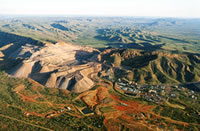 The Argyle diamond mine in Australia, owned by Rio Tinto Diamonds, announced they are remaining open. The Argyle mine is located in the remote East Kimberley region of northern Western Australia. Perth, the capital city of Western Australia, is a three-hour flight away from the mine site, and Kununurra, the closest town, a two-hour drive. For many years, they have been surface mining diamonds but have exhausted surface opportunities and will now have to use underground mining processes.
The Argyle diamond mine in Australia, owned by Rio Tinto Diamonds, announced they are remaining open. The Argyle mine is located in the remote East Kimberley region of northern Western Australia. Perth, the capital city of Western Australia, is a three-hour flight away from the mine site, and Kununurra, the closest town, a two-hour drive. For many years, they have been surface mining diamonds but have exhausted surface opportunities and will now have to use underground mining processes.
Argyle will be spending some $900 million to move to the underground mining operations with production dropping to about 60% of the current 34 million carats per year production. The Argyle mine provides about 17 percent of the world volume of diamonds but most of the diamonds are smaller, near gem quality and often brown in color.
The news to remain open is good news to the 250,000 workers in India whose jobs depend on the supply of these smaller, lower quality stones.
With the lower produce and higher costs of underground mining, the price of Argyle diamonds could increase as much as 15% over the next several years. However, the cost of rough diamonds is only a small part of the polished diamond price so the finished products might increase about 3% in price due to this change in mining operations.
Colored diamond lovers worldwide are glad to hear the Argyle is continuing operations because the Argyle mine is the leading producer of colored diamonds, especially the celebrated pink colors.
DE BEERS TO STOP BUYING DIAMONDS FROM ALROSA
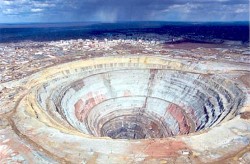 De Beers, the world’s biggest diamond company, will have to stop buying rough diamonds from Alrosa, the firm that controls Russia’s diamond production. This is a result of failing to follow European Commission rules.
De Beers, the world’s biggest diamond company, will have to stop buying rough diamonds from Alrosa, the firm that controls Russia’s diamond production. This is a result of failing to follow European Commission rules.
The commission said De Beers’ promise to stop buying gems from Alrosa, its nearest rival, by 2009 would bring genuine competition to diamond supply of rough diamonds which was about a $12 billion market in 2004.
The EU said the settlement was approved under a process that allows firms to make binding commitments to avoid abusive practices, but without admitting wrongdoing. De Beers faces fines up to 10% of its global turnover if it breaks the deal.
As part of the agreement, De Beers’ purchase of Alrosa rough diamonds will reduce from $600 million in 2006 to $500 million in 2007 and $400 million in 2008 followed by total refrain from all purchases of rough diamonds from Alrosa.
De Beers, which is 45% owned by mining conglomerate Anglo-American, accounted for about half the world market in 2005 while Alrosa, mines nearly a quarter of the world’s diamonds.
INCLUSIONS & BLEMISHES: NATURAL AND CAVITY
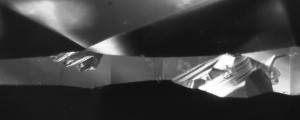 The girdle of a diamond often has naturals, which are the outer surface of the rough diamond crystal left after the cutting and polishing process. Naturals are recognized under the microscope because of the texture that is either serrated lines or small triangles, known as trigons. The photo above shows two naturals. The one on the left is a regular natural because of its location within the girdle area. The larger natural on the right is an indented natural because it extends above and below the girdle and has more depth to it. Keep in mind a natural was the surface of the rough crystal and the rest of the diamond was cut away. A natural is typically not a durability issue compared to a chip or cavity where part of the diamond has broken away.
The girdle of a diamond often has naturals, which are the outer surface of the rough diamond crystal left after the cutting and polishing process. Naturals are recognized under the microscope because of the texture that is either serrated lines or small triangles, known as trigons. The photo above shows two naturals. The one on the left is a regular natural because of its location within the girdle area. The larger natural on the right is an indented natural because it extends above and below the girdle and has more depth to it. Keep in mind a natural was the surface of the rough crystal and the rest of the diamond was cut away. A natural is typically not a durability issue compared to a chip or cavity where part of the diamond has broken away.
There is a cavity located at the right side of the indented natural. A cavity is where a part of the diamond has broken away leaving a void. The cavity has a relatively smooth texture that is very different from the lines of the natural.
ALTERNATIVE WHITE METAL
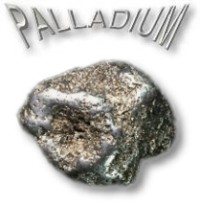 Platinum, white gold and silver have been the primary white metals in the jewelry industry for years but with the record prices for these precious metals, alternative white metals are experiencing growing demand.
Platinum, white gold and silver have been the primary white metals in the jewelry industry for years but with the record prices for these precious metals, alternative white metals are experiencing growing demand.
Palladium is a lustrous precious metal, in the platinum metals group. With a white-gray natural color, palladium is whiter than platinum and has similar characteristics that it will not tarnish or change color and it is hypoallergenic for consumers with sensitive skin. It is 12.6 percent harder, more malleable and less dense than platinum. Since it is lighter and less expensive than platinum, it promises to be the lower cost option for white metal jewelry compared to platinum or white gold.
Stainless steel, titanium and tungsten are the other white metals that are seeing increased demand in the jewelry industry. While gold and platinum have been the metal of choice for women’s jewelry, stainless steel, titanium and tungsten are shaping the men’s market where consumers are already familiar with the metals in products like gold clubs and watches. These metals are lightweight, strong, durable, and resist corrosion, scratching, denting, and bending; all characteristics valued by the active and physical lifestyles of the male shopper.
GEMSTONES: PYRITE
Pyrite is the classic “Fool’s Gold”. There are other shiny brassy yellow minerals, but pyrite is by far the most common and the most often mistaken for gold. Ironically, small quantities of the actual gold are sometimes found in pyrite. Whether it is the golden look or something else, pyrite is a favorite among rock collectors. It can have a beautiful luster and interesting crystals. It is so common in the earth’s crust that it is found in almost every possible environment; hence, it has a vast number of forms and varieties.
The name pyrite is from the Greek word “Pyr” meaning “fire”. This may be likely due to the sparks that result when pyrite strikes against steel.
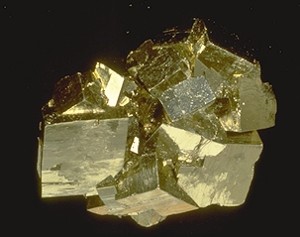 Pyrite reaches its greatest value in its various crystal forms as mineral specimens. Its value when used as a gem has generally been rather modest. Pyrite is often confused with the mineral marcasite, a name derived from the Arabic word for pyrite, due to their similar characteristics. Marcasite is a polymorph of pyrite, which means it has the same formula as pyrite but a different structure and, therefore, different symmetry and crystal shapes. Pyrite is used in jewelry such as necklaces and bracelets, but although the two are similar, marcasite cannot be used in jewellery as it has a tendency to crumble into powder.
Pyrite reaches its greatest value in its various crystal forms as mineral specimens. Its value when used as a gem has generally been rather modest. Pyrite is often confused with the mineral marcasite, a name derived from the Arabic word for pyrite, due to their similar characteristics. Marcasite is a polymorph of pyrite, which means it has the same formula as pyrite but a different structure and, therefore, different symmetry and crystal shapes. Pyrite is used in jewelry such as necklaces and bracelets, but although the two are similar, marcasite cannot be used in jewellery as it has a tendency to crumble into powder.
Pyrite is the most common form of the sulfide minerals. It is typically found with other sulfides and oxides in quartz veins, sedimentary rock and metamorphic rock, as well as in coal beds, and as the replacement mineral in fossils. Pyrite exposed to the environment during mining and excavation reacts with oxygen and water to form sulfuric acid, resulting in acid mine drainage.
Although pyrite is common and contains a high percentage of iron, it has never been used as a significant source of iron because pyrite is not as economical as other ores possibly due to their tendency to form larger concentrations of more easily mined material. Pyrite would be a potential source of iron if other ores should become scarce.
Pyrite was mined for its sulfur content during World War II when, sulfur was in demand as a strategic chemical and North American native sulfur mines were drying up. A sulfide deposit near Ducktown, Tennessee was mined for pyrite and produced the needed sulfur as well as iron and other metals. Sulfur is used in the production of sulfuric acid, an important chemical for industrial purposes. Now most sulfur production comes from hydrogen sulfide gas recovered from natural gas wells.
